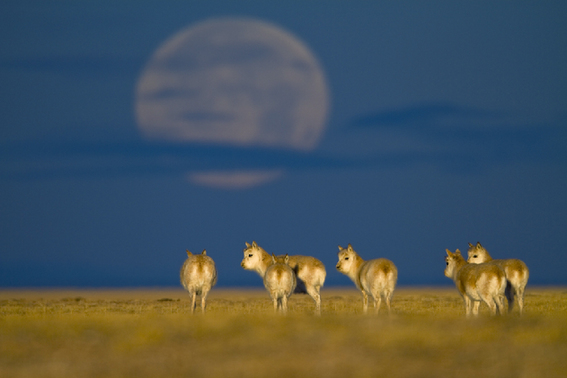Wild China
- By Zhao Yue
 0 Comment(s)
0 Comment(s) Print
Print E-mail China Pictorial, September 4, 2013
E-mail China Pictorial, September 4, 2013
 |
|
Tibetan Antelope (Pantholops hodgsonii,Kekexili, Qinghai, Jan. 2010) [Photo/Xi Zhinong/WildChinaFilm] |
Development of human society, especially industry, poses great threats to biodiversity and wildlife. On a global scale, from the 1970s to the end of 2008, it is estimated that the total population of wildlife dropped 25 percent.
China's wildlife protection also faces many challenges. Whitepaper on China's Population, Environment, and Development in the 21st Century notes that 15 to 20 percent of China's plants and animals are threatened with extinction, a higher proportion than the world average of 10 to 15 percent. Of all the wildlife, large mammals face the greatest threats. Excessive hunting, pollution, and city expansion have threatened such species across the board.
According to data compiled by the World Wide Fund for Nature (WWF), the populations of 12 animals in many of China's ecosystems have recently plummeted. The Yangtze River dolphin's population dropped 99.4 percent between 1980 and 2006, while the Chinese alligator lost 97 percent from 1955 to 2010.
| Stories not to miss: |
|
• Habitat is key |
Siberian tiger numbers fell 92 percent from 1975 to 2009 due to hunting, deforestation, habitat loss and intensified human activity. Although the study added that due to greater conservation and reintroduction efforts, some of China's "star species," such as the giant panda, have seen gradual recoveries, on the whole, the wildlife protection situation is not looking optimistic.
With such gloomy numbers, the Chinese government faces imperative responsibility. In 1950, China issued Protective Measures for Rare Species. In 1956, the country set up its first group of conservation areas. Since the country's introduction of reform and opening-up in 1978, China has pushed all-in on establishing and improving wildlife laws and regulations, establishing an effective administrative system, protecting as well as expanding wildlife habitats, saving, breeding and releasing wildlife back to nature.
As a country with long borders, China faces a complicated issue of wildlife poaching and smuggling. Still, the nation is making every effort to regulate and supervise wildlife breeding and utilization, and to crack down on poaching and smuggling. In 2012 alone, nearly 10,000 cases were discovered during crackdowns, and 1.13 million wild animals and products were seized. For example, for the snow leopard, a large endangered cat, China formulated special protection policy this May, planning to create 30 protected areas for the species in key areas such as the Qinghai-Tibet Plateau and Qilian Mountains within ten years.






Go to Forum >>0 Comment(s)